General Sir John Monash, Personal Files Book 17, 11 February - 18 March 1918, Part 3
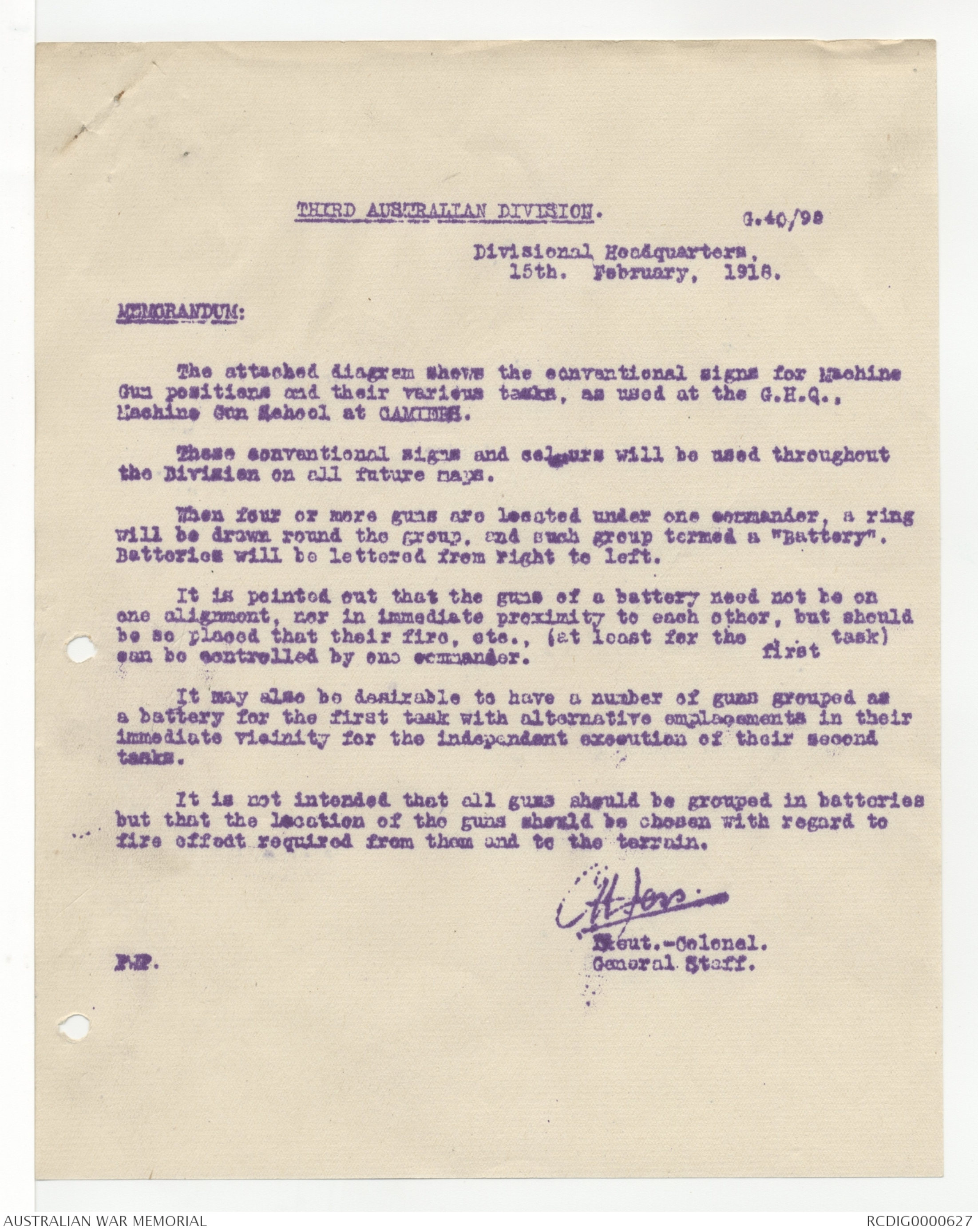
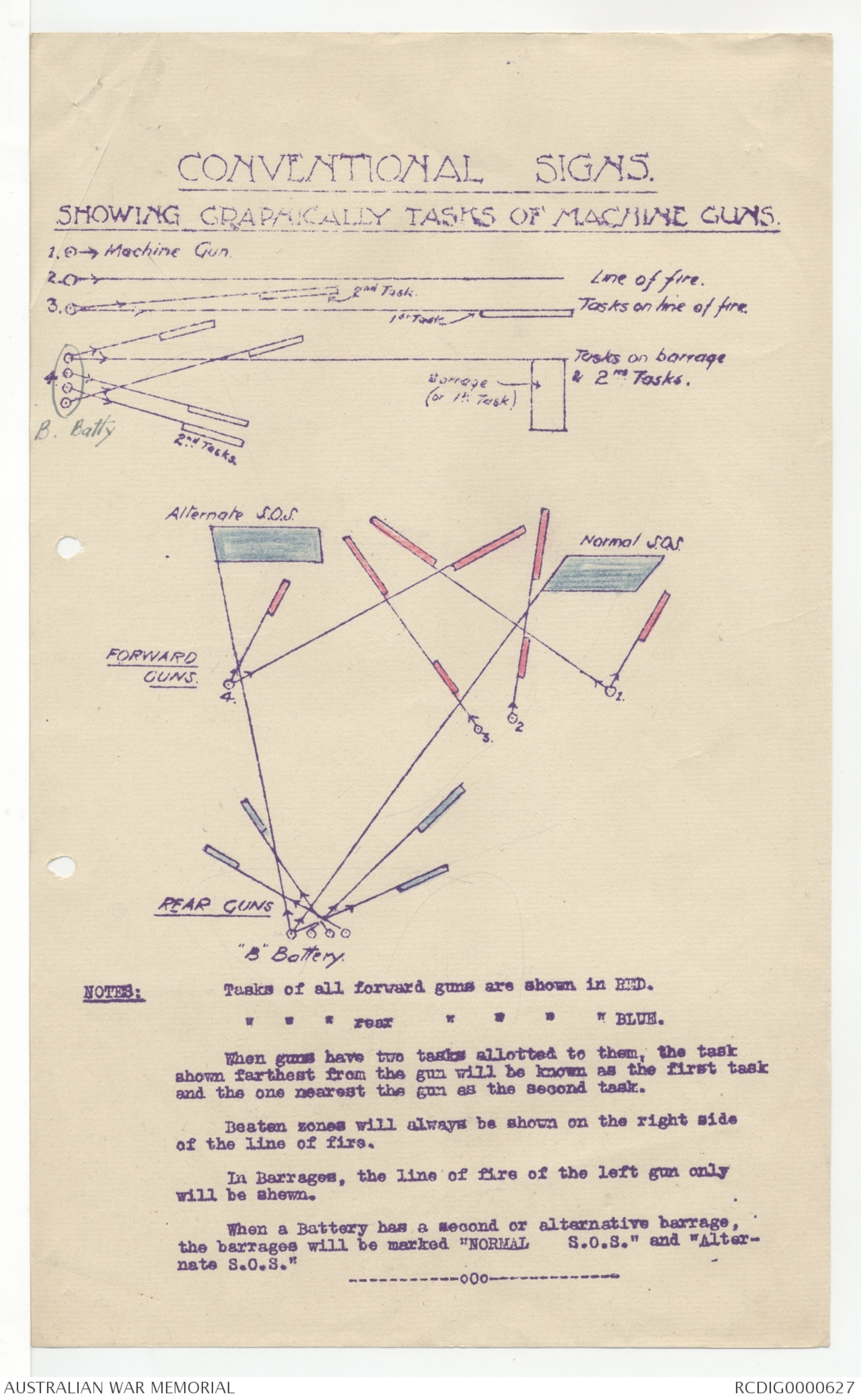
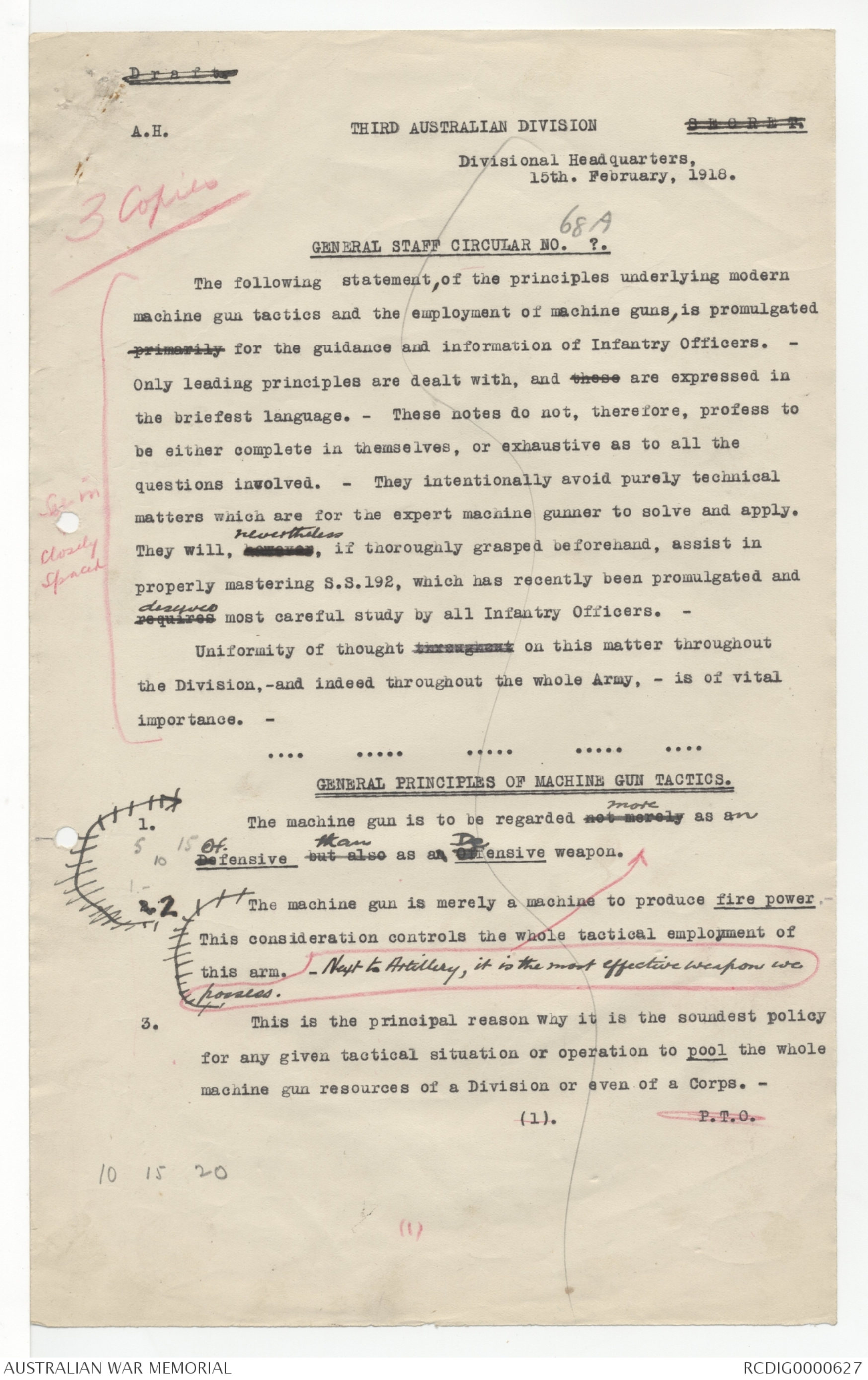
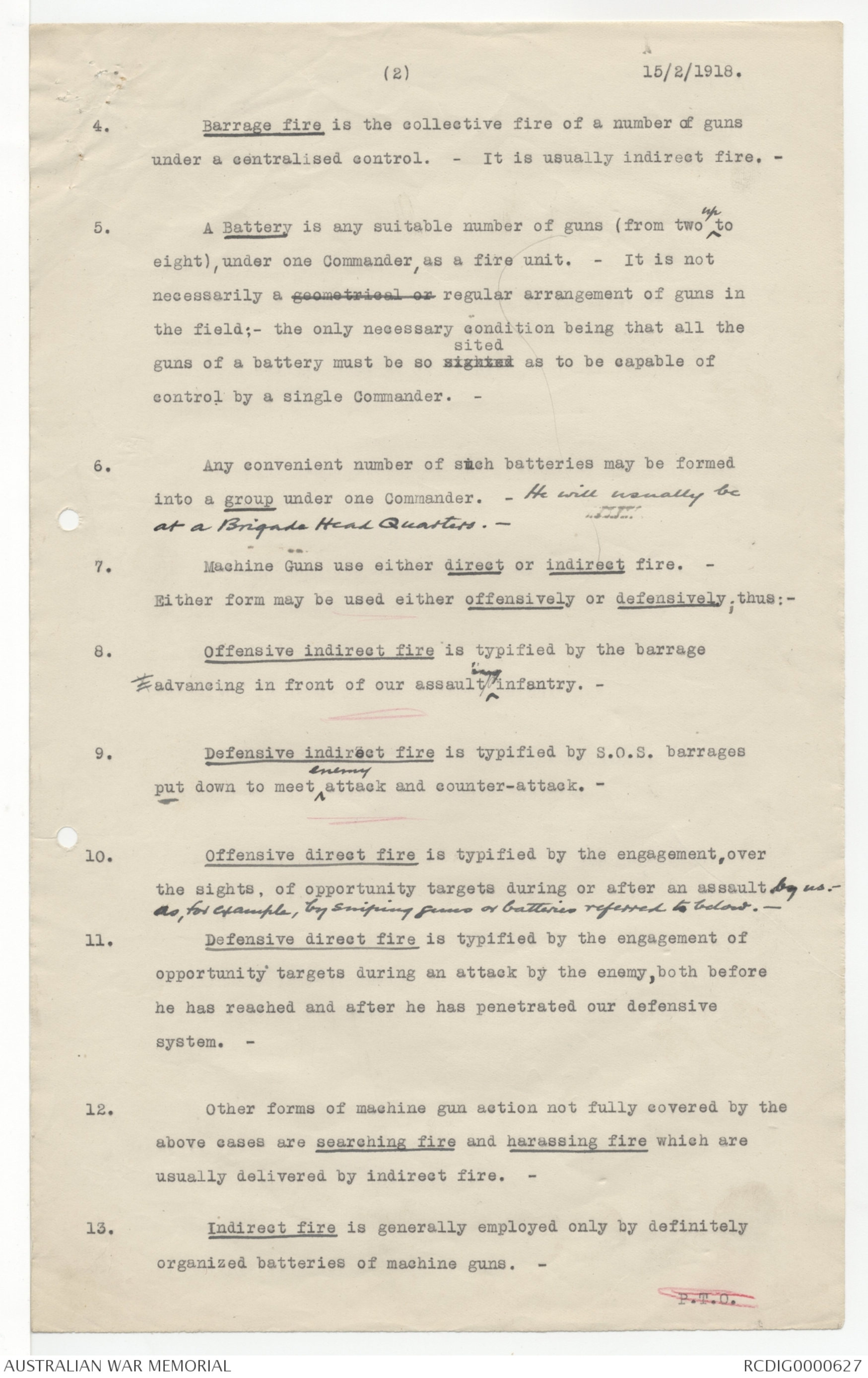
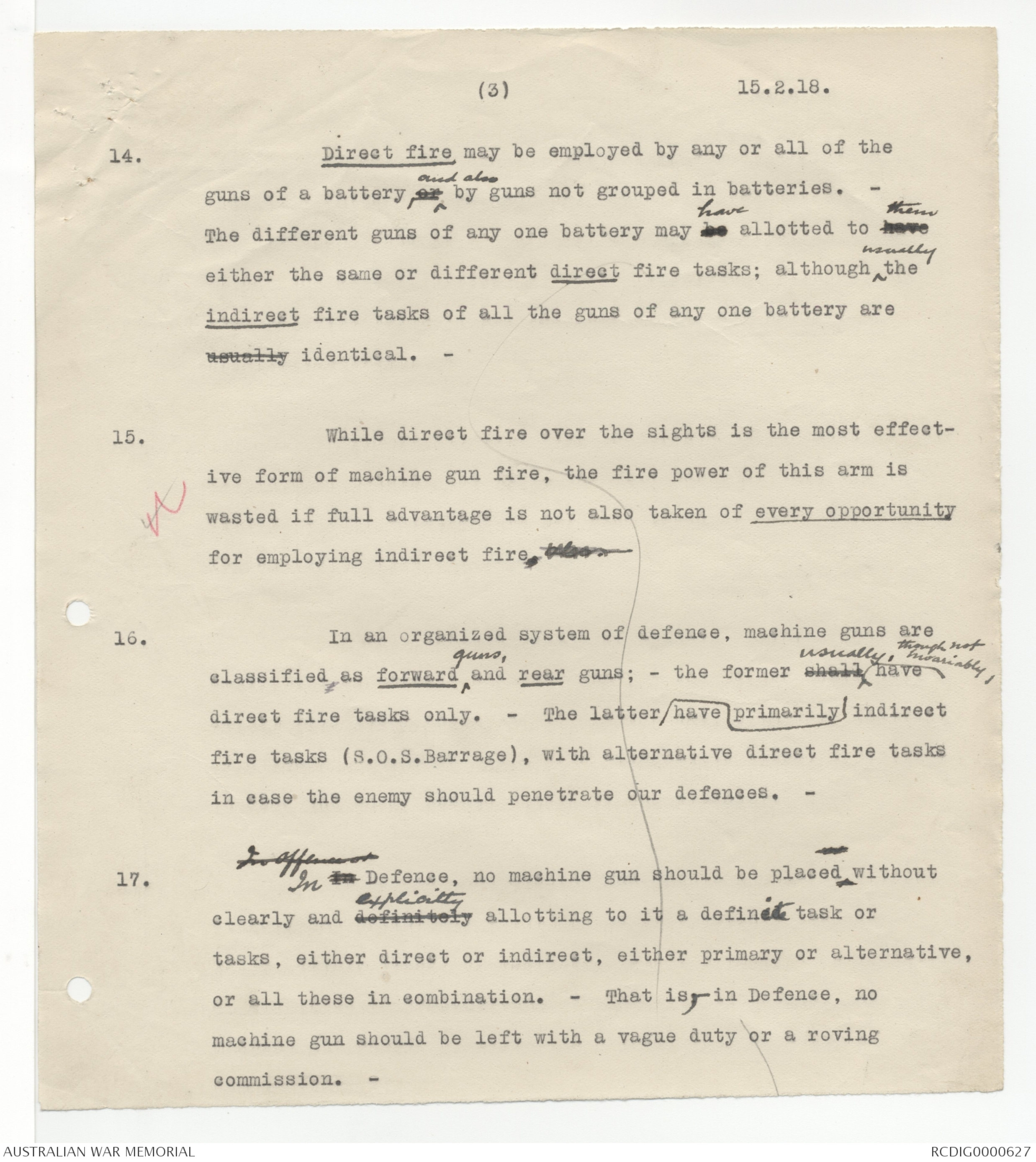
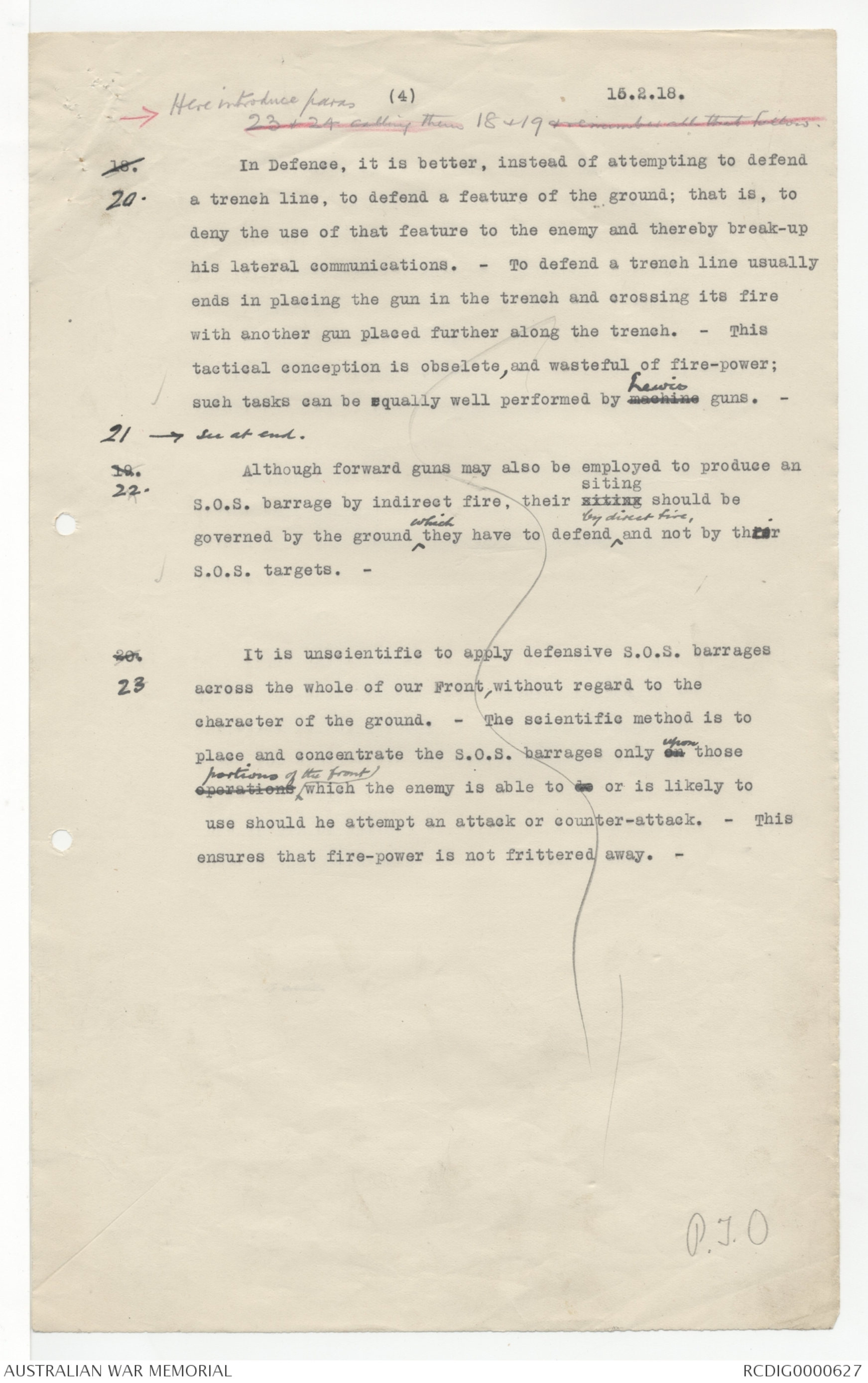
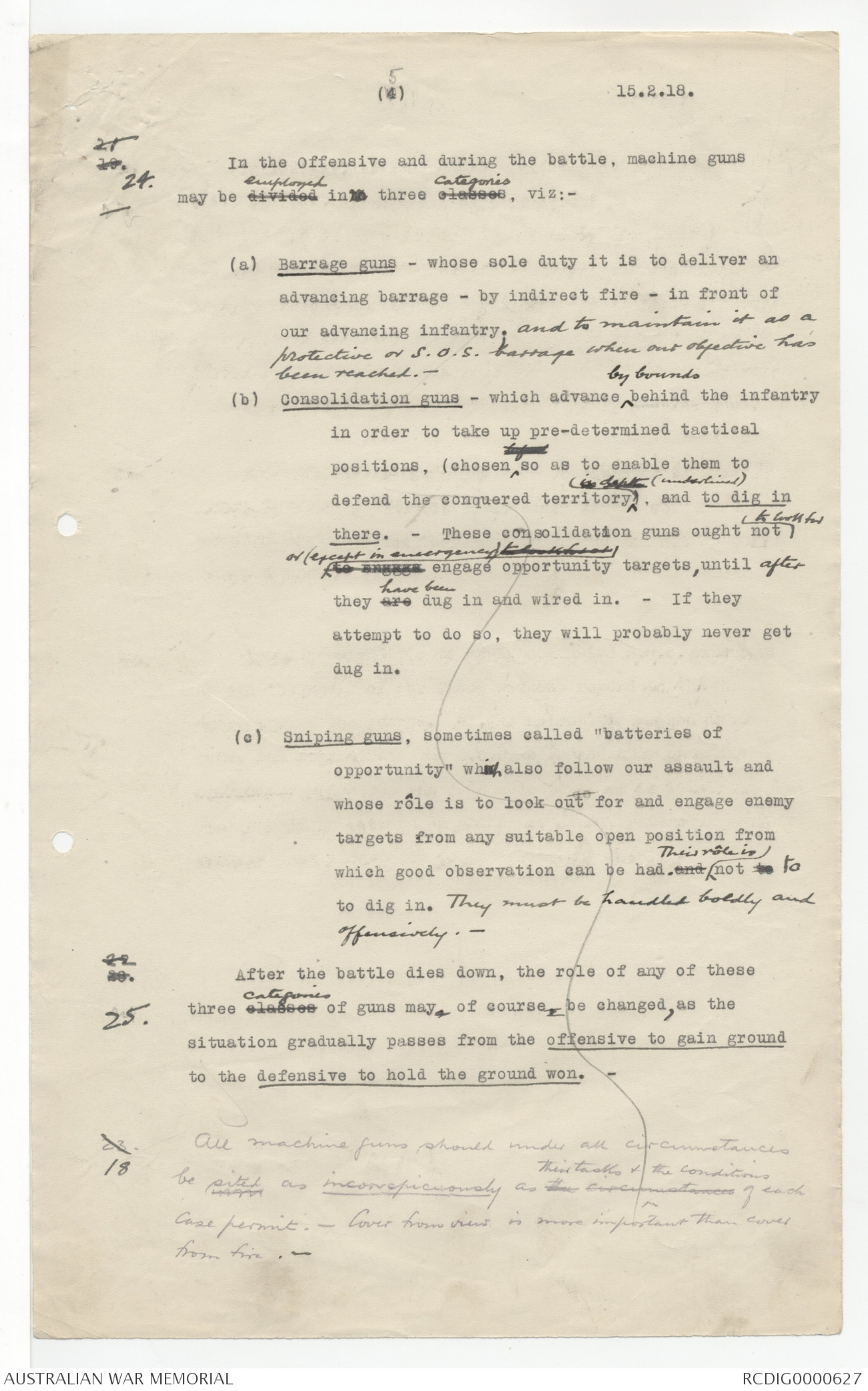
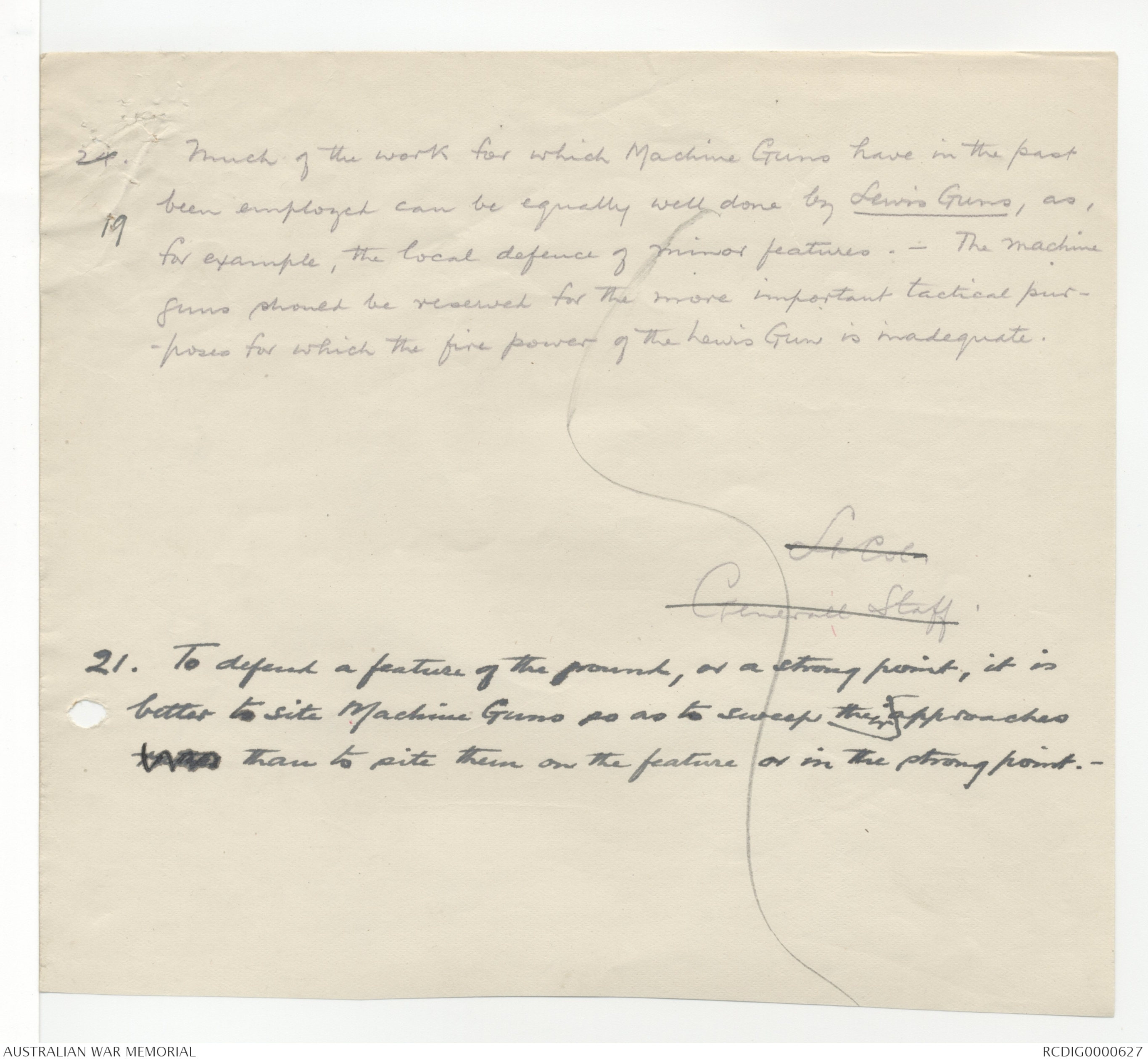
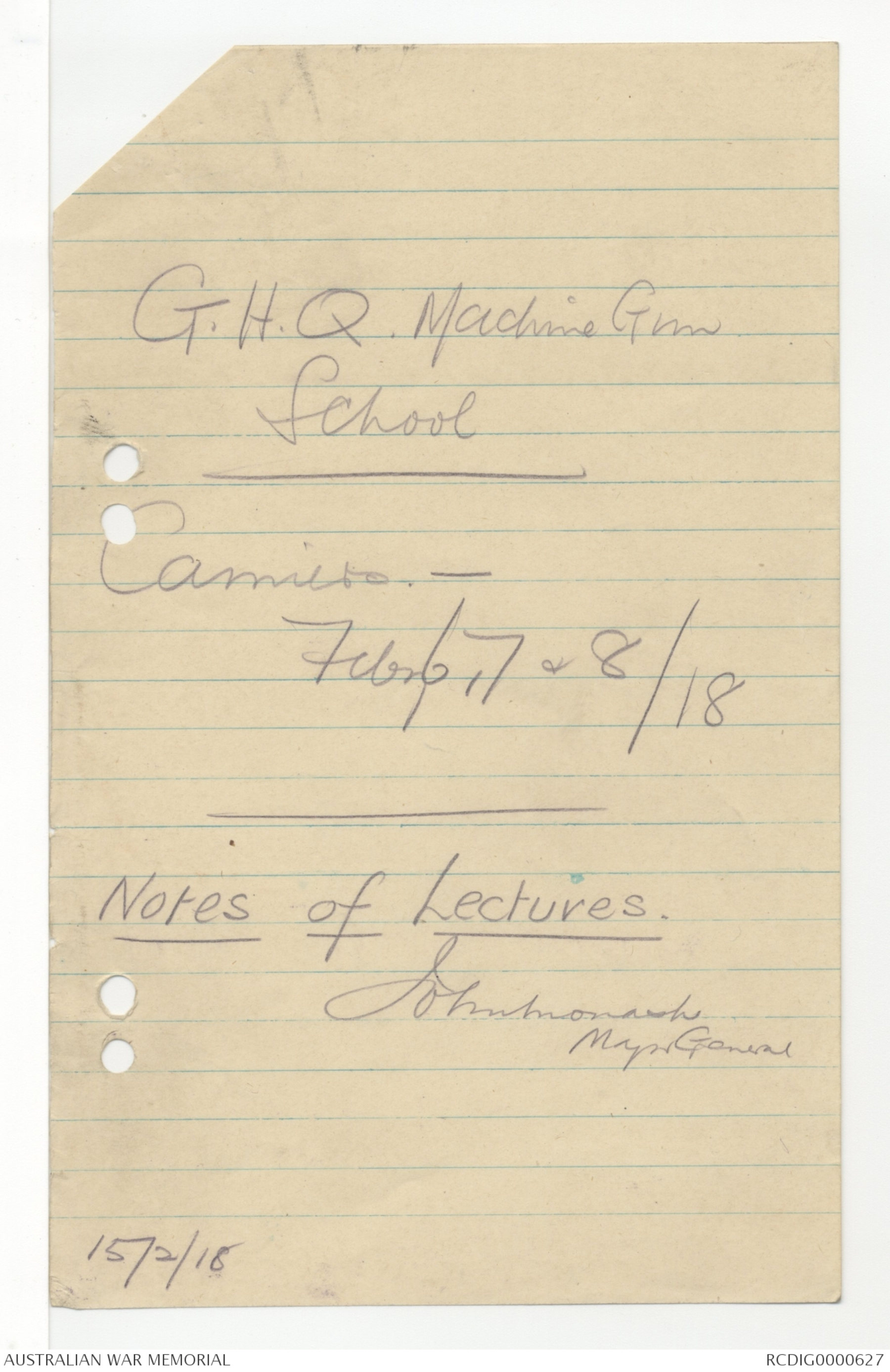
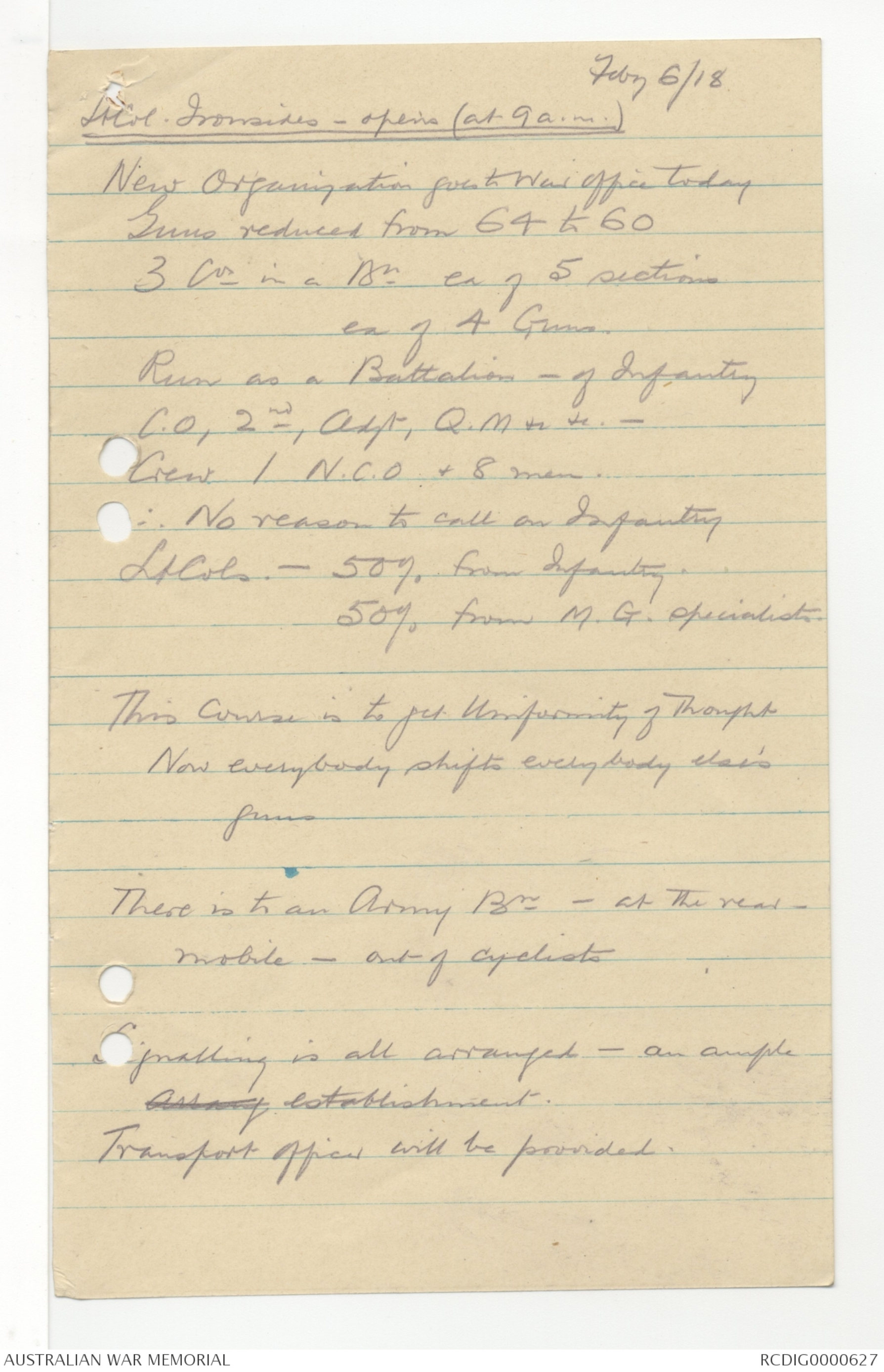
THIRD AUSTRALIAN DIVISION.
G.40/98
Divisional Headquarters,
15th. February, 1918.
MEMORANDUM:
The attached diagram shows the conventional signs for Machine
Gun positions and their various tasks, as used at the G.H.Q.,
Machine Gun School at CAMIERS.
These conventional signs and colours will be used throughout
the Division on all future maps.
When four or more guns are located under one commander, a ring
will be drawn round the group, and such group termed a "Battery".
Batteries will be lettered from right to left.
It is pointed out that the guns of a battery need not be on
one alignment, nor in immediate proximity to each other, but should
be so placed that their fire, etc., (at least for the first task)
can be controlled by one commander.
It may also be desirable to have a number of gunn grouped as
a battery for the first task with alternative emplacements in their
immediate vicinity for the independent execution of their second
tasks.
It is not intended that all guns should be grouped in batteries
but that the location of the guns should be chosen with regard to
fire effort required from them and to the terrain.
CH Jess.
Lieut.-Colonel.
General Staff.
P.P.
CONVENTIONAL SIGNS.
SHOWING GRAPHICALLY TASK OF MACHINE GUNS.
Diagram - see original document
NOTES: Tasks of all forward guns are shown in RED.
" " " rear " " " " BLUE.
When guns have two tasks allotted to them, the task
shown farthest from the gun will be known as the first task
and the one nearest the gun as the second task.
Beaten zones will always be shown on the right side
of the line of fire.
In Barrages, the line of fire of the left gun only
will be shown.
When a Battery has a second or alternative barrage
the barrages will be marked "NORMAL S.O.S." and
"Alternate S.O.S."
Draft
A.H.
THIRD AUSTRALIAN DIVISION SECRET.
Divisional Headquarters,
15th. February, 1918.
3 Copies
GENERAL STAFF CIRCULAR NO. ?. 68A
The following statement, of the principles underlying modern
machine gun tactics and the employment of machine guns, is promulgatedprimarily for the guidance and information of Infantry Officers. -
Only leading principles are dealt with, and these are expressed in
the briefest language. - These notes do not, therefore, profess to
be either complete in themselves, or exhaustive as to all the
[*Set in
closely
spaced*]
questions involved. - They intentionally avoid purely technical
matters which are for the expert machine gunner to solve and apply.
They will, however, nevertheless, if thoroughly grasped beforehand, assist in
properly mastering S.S.192, which has recently been promulgated andrequires deserves most careful study by all Infantry Officers. -
Uniformity of thought throughout on this matter throughout
the Division,-and indeed throughout the whole Army, - is of vital
importance. -
GENERAL PRINCIPLES OF MACHINE GUN TACTICS.
Diagram- see original document
1. The machine gun is to be regarded not merely more as an
DeOffensive but also than as a OfDefensive weapon. Next to Artillery, it is the
most effective weapon we
possess.
2. The machine gun is merely a machine to produce fire power.
This consideration controls the whole tactical employment of
this arm.
3. This is the principal reason why it is the soundest policy
for any given tactical situation or operation to pool the whole
machine gun resources of a Division or even of a Corps. -
(1)
P.T.O
10.15.20
(1).
(2) 15/2/1918.
4. Barrage fire is the collective fire of a number of guns
under a centralised control. - It is usually indirect fire. -
5. A Battery is any suitable number of guns (from two ^up to
eight), under one Commander, as a fire unit. - It is not
necessarily a geometrical or regular arrangement of guns in
the field;- the only necessary condition being that all the
guns of a battery must be so sighted sited as to be capable of
control by a single Commander. -
6. Any convenient number of such batteries may be formed
into a group under one Commander. - He will usually be
at a Brigade Head Quarters. -
7. Machine Guns use either direct or indirect fire. -
Either form may be used either offensively or defensively; thus: -
8. Offensive indirect fire is typified by the barrageX advancing in front of our assaulting infantry.
9. Defensive indirect fire is typified by S.O.S. barrages
put down to meet ^enemy attack and counter-attack. -
10. Offensive direct fire is typified by the engagement, over
the sights, of opportunity targets during or after an assault by us. -
as, for example, by sniping guns or batteries referred to below. -
11. Defensive direct fire is typified by the engagement of
opportunity targets during an attack by the enemy, both before
he has reached and after he has penetrated our defensive
system.-
12. Other forms of machine gun action not fully covered by the
above cases are searching fire and harassing fire which are
usually delivered by indirect fire. -
13. Indirect fire is generally employed only by definitely
organized batteries of machine guns. -P.T.O.
(3) 15.2.18.
14. Direct fire may be employed by any or all of the
guns of a battery, or ^and also by guns not grouped in batteries. -
The different guns of any one battery may be have allotted to have them
either the same or different direct fire tasks; although ^usually the
indirect fire tasks of all the guns of any one battery areusually identical.
15. While direct fire over the sights is the most effective
form of machine gun fire, the fire power of this arm is
wasted if full advantage is not also taken of every opportunity
for employing indirect fire. xxxx
16. In an organized system of defence, machine guns are
classified as forward ^guns and rear guns; - the former shall ^usually, though not invariably, have
direct fire tasks only. - The latter primarily have indirect
fire tasks (S.O.S.Barrage), with alternative direct fire tasks
in case the enemy should penetrate our defences. -
17. In offensive In In Defence, no machine gun should be placed without
clearly and definitely explicitly allotting to it a definite task or
tasks, either direct or indirect, either primary or alternative,
or all these in combination. - That is,-in Defence, no
machine gun should be left with a vague duty or a roving
commission. -
Here introduce paras (4) 15.2.18.23 & 24 cutting them 18 & 19 & combine all that follows.18. 20 In Defence, it is better, instead of attempting to defend
a trench line, to defend a feature of the ground; that is, to
deny the use of that feature to the enemy and thereby break-up
his lateral communications. - To defend a trench line usually
ends in placing the gun in the trench and crossing its fire
with another gun placed further along the trench. - This
tactical conception is obselete, and wasteful of fire-power;
such tasks can be equally well performed by machine Lewis guns. -
21 ⇢ See at end.19. 22. Although forward guns may also be employed to produce an
S.O.S. barrage by indirect fire, their sittng siting should be
governed by the ground ^which they have to defend ^by direct fire and not by their
S.O.S. targets. -20. 23 It is unscientific to apply defensive S.O.S. barrages
across the whole of our Front, without regard to the
character of the ground. - The scientific method is to
place and concentrate the S.O.S. barrages only on upon thoseoperations portions of the front ^which the enemy is able to do or is likely to
use should he attempt an attack or counter-attack. - This
ensures that fire-power is not frittered away.
P.T.O.
(4 5) 15.2.18.21 19. 24. In the Offensive and during the battle, machine guns
may be divided employed into three classes categories, viz:-
(a) Barrage guns - whose sole duty it is to deliver an
advancing barrage - by indirect fire - in front of
our advancing infantry, and to maintain it as a
protective or S.O.S. barrage when our objective has
been reached. -
(b) Consolidation guns - which advance ^by bounds behind the infantry
in order to take up pre-determined tactical
positions, (chosen ^xxx so as to enable them to
defend the conquered territory),^in depth (underlined) and to dig in
there. - These consolidation guns ought not to look for
or ^(except in emergency) to be engaged engage opportunity targets, until after
they are have been dug in and wired in. - If they
attempt to do so, they will probably never get
dug in.
(c) Sniping guns, sometimes called "batteries of
opportunity" which also follow our assault and
whose rôle is to look out do for and engage enemy
targets from any suitable open position from
which good observation can be had. and This rôle is ^not to-to
to dig in. They must be handled boldly and
offensively.-22 20. 25. After the battle dies down, the role of any of these
three classes categories of guns may, of course, be changed, as the
situation gradually passes from the offensive to gain ground
to the defensive to hold the ground won. -23. 18. All machine guns should under all circumstances
be xxxx sited as inconspicuously as the circumstances their task & the conditions of each
case permits. - Cover from view is more important than cover
from fire. -
24. 19 Much of the work for which Machine Guns have in the past
been employed can be equally well done by Lewis Guns, as,
for example, the local defence of minor features. - The machine
guns should be reserved for the more important tactical purposes
for which the fire power of the Lewis Gun is inadequate.Lt ColGeneral Staff.
21. To defend a feature of the ground, or a strong point, it is
better to site Machine Guns so as to sweep their approachesxxxx than to site them on the feature or in the strong point.-
G.H.Q. Machine Gun
School
Camiers -
Feby 6, 7 & 8/18
Notes of Lectures.
John Monash
Major General
15/2/18
Feby 6/18.
Lt. Col. Ironsides - opens (at 9 a.m.)
New Organisation goes to War Office today
Guns reduced from 64 to 60
3 Cos in a Bn ea of 5 sections
ea of 4 Guns.
Run as a Battalion - of Infantry
C.O, 2nd Adjt, Q.M &c &c. -
Crew 1 N.C.O & 8 men.
therefore No reason to call on Infantry
LtCols. - 50% from Infantry.
50% from M.G. specialists.
This course is to get uniformity of thought
Now everybody shifts everybody else's
guns.
There is to an Army Bn - at the rear -
mobile - out of cyclists
Signalling is all arranged - an amplearrang establishment.
Transport officer will be provided.
 Daphne
DaphneThis transcription item is now locked to you for editing. To release the lock either Save your changes or Cancel.
This lock will be automatically released after 60 minutes of inactivity.